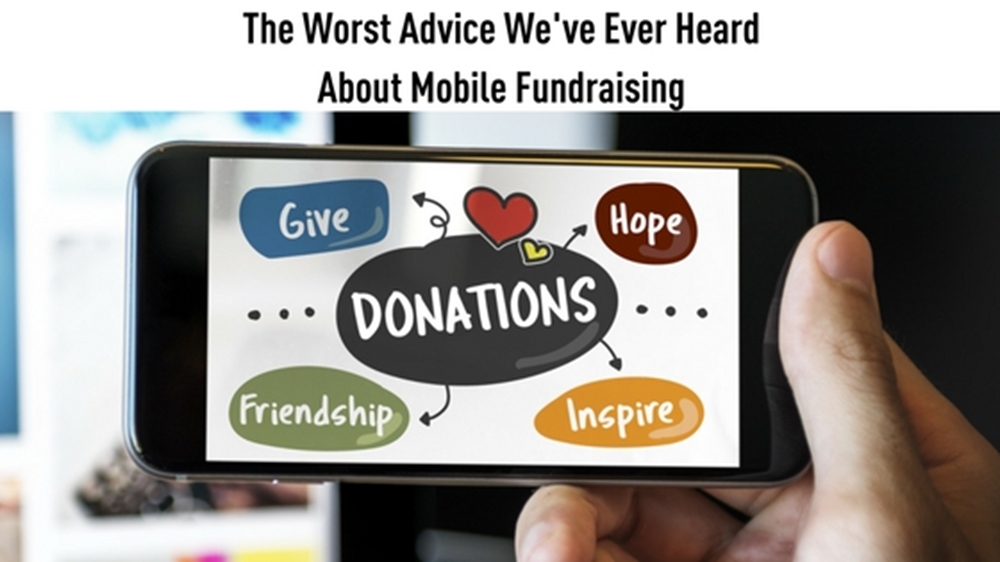Newsroom
The Worst Advice We've Ever Heard About Mobile Fundraising (That Every Nonprofit Needs To Know)

Fundraising is a hard enough task for your nonprofit – but you also need to think about year round and cross device. How will you raise funds? Where will you do it? Who are you gleaning information from for these endeavors?
We’ve compiled some of the worst advice we’ve ever heard about mobile fundraising—read on to learn why following it can actually do more harm than good.
“No one wants to make donations with their mobile phone.”
WHAT? On the contrary, mobile giving has increased year after year since the invention of the smartphone.
In 2015, 14% of donations came from a mobile device, and during the giving season mobile giving increased 45%. This trend will continue to grow year after year along with mobile device ownership.
People are using their phones to donate more. This rise in mobile donations is not just because more people have the devices, but because the whole web is adopting mobile-friendly responsive experiences. People no longer have to rely on using a desktop to be able to fill out a form or make a donation.
“Text messages aren’t personal and they feel like spam.”
Connecting with your organization’s supporters is crucial to the success of your mission. The single best way to get in touch with them is through text message.
Why? People are very attached to their cell phones, checking them an average of 46 times a day. Plus, text messaging has an astounding 98% open rate, meaning that your supporters are seeing whatever messages you send to them by text almost every single time.
A best practice is to send at least 3 texts with compelling content such as links to videos, web pages and social campaigns before ever asking for a donation. This will keep people engaged and connected to your cause in the most convenient way possible and go a long way to preventing them from opting out.
“Mobile fundraising is just not as effective as your more traditional channels.”
In reality, organizations that implement mobile and online fundraising technologies in addition to using traditional means of fundraising successfully maximize their revenues, donor count, and advocate participation more so than organizations that don’t.
The key to that success lies within your organization segmenting its communications approach in order to resonate best with different age group demographics—whether you are communicating via direct mail, social, online, phone or email.
Here are the preferred communication channels of different generations of donors:
Millennials:
Donors between the ages of 22-36 are most likely to watch campaign videos, donate via mobile, and prefer to give via crowdfunding. These individuals tend not to carry cash or checks and prefer responding to text messaging, and are active daily on social media. According to the new Millennial Impact Report, 91% of millennials said that they used Facebook to post about, or engage with, an issue they care about.
Generation X:
Donors ages 37-51 are most likely to fundraise on behalf of your organization, make a pledge, and volunteer. These supporters respond to email, phone calls, and texts and stay up-to-date on social feeds and trends.
Baby Boomers:
Donors ages 52-66, are most likely to make recurring gifts. These supporters respond best to phone calls, check email regularly, and are mainstream adopters of text messaging and social media.
Greatest Generation:
Donors who are 67 or older are most likely to respond to direct mail and give by check. Wealthy seniors are more likely to own smartphones and donate by credit card.
“Only young people use mobile phones and they don’t really donate.”
Younger generations definitely use their phones more than older generations, however, in the last few years, older donors are increasingly using mobile devices, and that includes engaging with nonprofit organizations online.
For donors over 50, the use of mobile to interact with charities increased 30% from 2013 to 2015. Keep this in mind for your next fundraising campaign as these numbers are projected to grow year after year.
Millennials already prefer everything to be mobile and are largely resistant to traditional forms of fundraising, direct mail, telemarketing, and formal events. But while they’ve gotten a bad reputation among older generations, studies actually show that 84% of millennials made a donation in 2014 and 70% spent at least an hour volunteering. They also give an average of $481 annually with crowdfunding as their preferred method of giving.
It’s also important to note that these younger donors between the ages of 18 and 34 now make up more than 50% of the workforce in the United States, earning incomes that will allow them to support your cause.
“Mobile fundraising can’t really help you at a live fundraising event.”
Regardless of the type of fundraising event that you are holding, mobile fundraising and communications help you create a smooth experience from start to finish that can boost momentum for more donations from new and existing donors.
From the planning stages to RSVPs and ticketing to the day of, and even long after your fundraising event is over, mobile and online technology can help your organization reach, engage and make it easy for donors to support your cause.
Event Planning
Before the Event: Promote registrations across all your marketing channels and encourage out-of-towners to make donations that will be displayed on-screen at the event. 19.6% of events registrations come from mobile devices which equates to 1 out of every 5 attendees!(TWEET THIS) Text messages can be sent to registrants to communicate reminders, last-minute updates, directions and other pertinent information.
During the Event: Instruct attendees to text your keyword followed by their donation amount and name. Manually enter all offline gifts during the event to maintain momentum until the goal is reached. Live fundraising thermometers that capture and display mobile pledges and donations also help to build the excitement during asks and can increase event giving by 35%.
After the Event: Send links to thank you videos and event highlight reels. Even weeks after the event, ongoing mobile alerts with compelling links to videos and opportunities keep donors connected to your cause all year long.
“Mobile fundraising means your organization is limited to collecting only $5 and $10 donations.”
In the past, donating through your phone using text messages meant that you were limited to $5 or $10 donations, which were charged directly to your donors’ phone bills by service carriers. Unfortunately, people still think this is the only way to use mobile fundraising. And while that still may be the case for some text-to-give providers, advances in mobile and online fundraising technology now actually allow you to do much more.
Donors can now text a keyword to receive a message that includes a link to an online form where they can give as much as they like using their credit cards to make a one-time or recurring donation.
Always be on the lookout for new ways to incorporate mobile and online giving into your day-to-day operations and use it to help you nurture donor relationships. Online giving is the entry point for long-term relationships and can lead to larger gifts and repeat giving.
“Fundraising using mobile and online software is too hard and a waste of time.”
The reality is that fundraising software has never been easier to use than it is today. Many fundraising software solutions like MobileCause are designed specifically for nonprofit organizations and enable you to create online donation forms, set up crowdfunding campaigns, send text messages and much more in just minutes.
As more and more organizations continue to adopt mobile fundraising to help them raise more money in less time with less effort, organizations that don’t adapt risk getting left out in the cold because of outdated advice and fears. Instead, get started using these fast, flexible and secure solutions to help you reach and engage more donors and make it easy for them to give to your cause in just a few taps or clicks from any device, in response to every one of your fundraising campaigns. The sooner you start the better off you’ll be, now and in the future.
Author bio:

Steve Page is a blogger, marketer, and webmaster for MobileCause, a mobile and online fundraising software platform for a new generation of donors. Steve enjoys helping nonprofit organizations with their websites and getting their online campaigns running successfully.
Previous Post
5 Visual Marketing Apps for Nonprofit Social Marketing